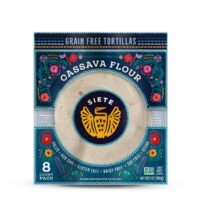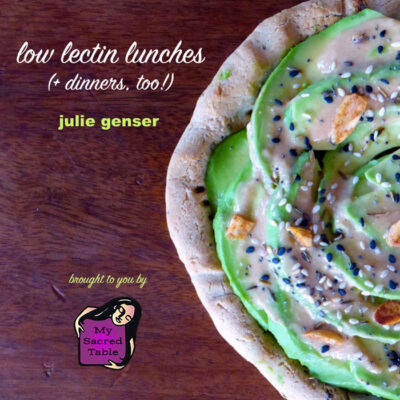Alfalfa – Avoid alfalfa and alfalfa sprouts; they are the one plant that increases in lectin content with sprouting.
Almonds – Not recommended (unless blanched) for a low lectin diet because their brown skins contain lectins. Can be used in moderation when prepared properly. Recommended prep: Soak at least 12 hours in water. Remove skins, which should come off easily after being soaked. Dehydrate or use immediately. Do not store wet, as they may mold.
Almond Flour – This page is currently under construction, more information coming shortly!
Avocado Oil – Avocados are very high in oleic acid, a monounsaturated fat that is also the major fat in olive oil. Oleic acid has been linked to reduced inflammation and other health benefits. The monounsaturated fatty acids in avocado oil are very resistant to heat-induced oxidation and with its high smoke point of 520 degrees Fahrenheit (271 degrees Celsius), avocado oil is the best oil to use for high temperature cooking. It can also be used cold in salads.
Avocados – Avocados are a fruit, and are high in vitamin K, folate, potassium, antioxidants, and over 20 other vitamins and minerals. They are loaded with monounsaturated fatty acids (shown to lower bad cholesterol), fiber and can significantly increase the antioxidant and other nutrient value of fat-soluble plant foods eaten with them or their oil. Dr. Gundry recommends eating a whole avocado daily in his Plant Paradox diet, though those with histamine issues may need to limit or avoid them because they are high in histamine.
Basil – Basil is a plant in the mint family. Its leaves are used as a culinary herb. There are many varieties of basil, and it is commonly used in pesto. It also goes well on pizza and in salads and stir-fries.
Beans – Beans are difficult to digest. They contain phytic acid which binds to minerals like magnesium, iron, and zinc, preventing their absorption and causing mineral deficiencies. They are also high in damaging lectins. The harder beans like kidney and navy beans contain oligosaccharides, a complex sugar that we cannot digest because humans do not produce alpha-galactosidase, the enzyme needed to break it down. For these reasons, it’s best to avoid beans, or eat them in moderation if you have digestive issues. For those further along in gut healing, Eden Foods does inactivate the lectins by soaking, steam-blanching, rinsing and then pressure-cooking all of their canned beans. Recommended prep: Soak in water for at least 12 hours, changing the water frequently. Rinse well before cooking. Cook in a pressure cooker.
Black Cumin Seeds – Allowed on a low-lectin diet.
Brazil Nuts – This page is currently under construction, more information coming shortly!
Cassava – Important: Please be aware that latex allergies can be cross-reactive with cassava.
Chestnuts – This page is currently under construction, more information coming shortly!
Coconut (Young Green) – This page is currently under construction, more information coming shortly!
Coconut (Mature) – This page is currently under construction, more information coming shortly!
Coconut Cream – This page is currently under construction, more information coming shortly!
Coconut Flour – This page is currently under construction, more information coming shortly!
Coconut Milk – This page is currently under construction, more information coming shortly!
Coconut Water – The one coconut product that is not considered safe on a low lectin diet due to it’s sugar content. It’s best to avoid, especially if you are diabetic or trying to lose weight.
Coconut Yogurt – This page is currently under construction, more information coming shortly!
Coriander Seeds – Allowed on a low lectin diet.
Cumin Seeds – Allowed on a low lectin diet.
Fennel Seeds – Allowed on a low lectin diet.
Flax Seeds – Allowed on a lectin-free diet according to Dr. Steven R. Gundry, author of The Plant Paradox.
Hazelnuts – This page is currently under construction, more information coming shortly!
Hemp Protein Powder – I’m personally a fan of organic whole foods over processed isolated food proteins, but this is acceptable on a low lectin diet.
Hemp Seeds – This page is currently under construction, more information coming shortly!
Macadamia Nuts – This page is currently under construction, more information coming shortly!
Millet – Millet, like sorghum, does not have a hull and is lectin-free — which means it does not have WGA (wheat germ agglutinin), a lectin that protects wheat from insects, yeast and bacteria. Millet and sorghum are the only two grains considered “safe” as-is for a lectin-free diet. (Other grains can be soaked and pressure cooked to remove lectins.) Millet can be cooked and eaten as a side dish with protein/vegetables or used as a flour in baking.
Pecans – This page is currently under construction, more information coming shortly!
Pine Nuts – This page is currently under construction, more information coming shortly!
Pistachios – This page is currently under construction, more information coming shortly!
Poppy Seeds – Allowed on a lectin-free diet because they have hard shells that make them indigestible — they will go right through you. This is a survival mechanism of plants, to protect their babies (seeds) in a hard shell so they can be ingested and pooped out to fertilize the soil with their seed. In these cases of the seed having a hard protective shell, they do not have lectins as their defense mechanism
Rice – If you are going to eat a grain, white rice is considered the safest choice by Dr. Steven R. Gundry, author of The Plant Paradox and originator of the low lectin diet. Why? Rice does not contain WGA (wheat germ agglutinin, a very small protein that causes inflammation and host of other symptoms). Choose white basmati rice from India because it contains the most resistant starch out of any rice variety. Recommended prep: Soak overnight in water to remove anti-nutrients, rinse, and pressure cook. To make the starch more resistant, refrigerate before eating, then reheat or use cold.
Sesame Seeds – A great source of magnesium, iron and calcium, sesame seeds are safe for a low-lectin diet. They are high in the anti-nutrient phytic acid so they must be soaked for at least 8 hours. Recommended prep: Soak in water at room temperature for 4 hours. Drain and rinse well. Soak for 4 more hours in a new batch of water. Drain and rinse well. Dry in dehydrator or pan toast.
Shiritake Noodles – Made from the root of a tuber called konjac, sometimes referred to as Japanese Yam, these noodles are easy to prepare and come in different varieties, including angel hair, spinach, fettucine and spaghetti. They will take on the flavor of whatever they are cooked with. Miracle Noodles is a popular brand. Recommended prep: Rinse well with water. Place in boiling water for 2-4 minutes. Drain and rinse. Dry on a heated skillet.
Sorghum – Sorghum does not have a hull and contains no lectins (including WGA or wheat germ agglutinin, a very small protein that causes inflammation and host of other symptoms) so it is safe for those following a low lectin diet. It has calcium and iron and can be cooked like a grain, used as a breakfast cereal, in a salad or popped like popcorn. The kernels are smaller than corn — they are quite cute + tasty when popped!
Walnuts – This page is currently under construction, more information coming shortly!
Water – It’s just, if not more, important to consider the source of your water than any other substance we ingest. The adult human body is made of up to 60% water — the brain and heart are each 73% water, the lungs are ~83%, the skin is 64% water, muscles and kidneys are 79%, and even the bones are watery: 31%. Water is a transmitter of energy, thought, and intention and directly affects the functioning of our mitochondria and cells. Aspects to consider when choosing your water source, filtering, and supplementation: 1) Source ideally your water will be from deep underground or high altitude aquifers + springs, or glacier melt water from polar areas or high altitudes (see the Sacred Pantry for some glacier/iceberg/spring waters available for purchase online); 2) Minerals It’s important that your water contain minerals. RO water removes all minerals so be sure to add a trace minerals solution back in if your water source is low or devoid of minerals; 3) Toxicants Untreated water from wells and springs can be contaminated with heavy metals, bacteria, viruses, parasites, and toxic chemicals. It’s important to test your water so you know whether you need to filter it, and for what; 4) Deuterium-Depleted Ideally you want to consume deuterium-depleted water, also known as light water. Deuterium is one of 2 isotopes of hydrogen that is stable in nature, but when bound to oxygen forms deuterium oxide (D2O) (heavy water) which is very toxic to most living beings. Normal sources of water have ~150 ppm of D2O; anything ~125 ppm or below is considered deuterium-depleted. (See the Sacred Pantry for sources of deuterium-depleted water.) 5) Structure Wild water is energized by the vortices formed as it flows in nature. When we take water from it’s wild source, filter it, bottle it in plastic, and ship it around the world it loses this energetic imprint and it’s natural negative charge. This changes its molecular structure and leaves it vulnerable to pathogens. Structuring your water will re-imbue it with the frequency of nature and will optimize your hydration. You can purchase structured water from most water stores or structure it yourself; 6) Intention Dr. Masaru Emoto completed groundbreaking work on the effect of human consciousness on the molecular structure of water. He found that certain words + thoughts could create much more coherent molecules, “love + gratitude” producing the most beautifully structured ice crystals of all. Whether you place stickers with these words on your water containers or direct these thoughts to your water each day, it’s a beautiful practice to create a water altar in your home that honors the special broadcasting properties of this life sustaining liquid. Some helpful water resources: finewaters.com | findaspring.com





















Recent Raves